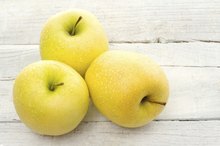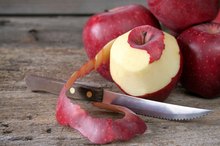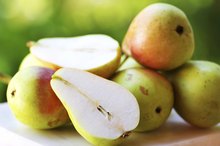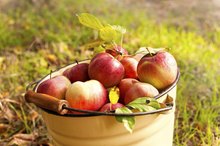What Is the Nutritional Value of a Gala Apple?
Originating in New Zealand in 1962, the Gala apple is related to the Golden Delicious apple and grows extensively in Washington. The Gala tastes sweet and has a distinctive aroma and crisp, firm texture. The Gala apple can be yellow with red stripes to nearly solid red in color. One medium apple weighing 5.5 ounces has 80 calories.
Antioxidants
Antioxidants are chemicals that prevent cell and tissue damage from free radicals in the body by preventing or reducing oxidation. According to the May 12, 2004 issue of "Nutrition Journal," apples and their antioxidants help lower the risk of heart disease, diabetes and cancer. Gala apples are a significant source of these damage-fighting chemicals.
Vitamins and Minerals
What Nutrients Are Lost When an Apple Oxidizes?
Learn More
Based on a 2,000-calorie-per-day diet, one medium Gala apple will supply you with 8 percent of your recommended daily value of vitamin C. That same little apple will provide you with 2 percent of your daily needs of iron and vitamin A. Also contained in the Gala is 5 percent of the potassium your body needs to be healthy.
Carbohydrates and Fiber
The natural fiber found in Gala apples is pectin. Apples possess more pectin than any other fruit. A diet high in fiber-rich apples has been shown to reduce blood pressure and prevent colon cancer. Apples are a source of both complex and simple carbohydrates. One medium gala apple supplies 22grams of carbohydrate. Fiber accounts for 5 of the 22 grams.
- The natural fiber found in Gala apples is pectin.
- One medium gala apple supplies 22grams of carbohydrate.
Phytochemicals and Flavonoids
Calories in a Yellow Apple
Learn More
Flavonoids are defensive phytochemicals found in apples. Flavonoids have been documented to have anti-viral, anti-allergic, anti-inflammatory, anti-tumor and antioxidant effects on the body. Research suggests that phytochemicals can protect against the aging process.
Freshness
You can test the apples firmness by holding it in the palm of your hand. The apple should feel solid and heavy, not soft and light. Fresh Gala apples should not have dark or soft spots. When rubbing your finger across the apple skin the skin should not wrinkle. Wrinkling indicates an apple that has not been kept cool enough or that the apple has been kept in cold storage for too long.
- You can test the apples firmness by holding it in the palm of your hand.
Use and Availability
Gala apples are often eaten fresh. Galas are also delicious in salads, pies, sauces and a number of baked goods. The Gala harvest season runs from October through January. Store the apples as cold as possible in your refrigerator. Gala apples do not freeze until they are below 28.5 degrees Fahrenheit.
- Gala apples are often eaten fresh.
- Galas are also delicious in salads, pies, sauces and a number of baked goods.
Related Articles
References
- Reed Valley Orchard.com: Gala
- Nutrition Journal: Apple Phytochemicals and Their Health Benefits
- Apple, raw. FoodData Central. U.S. Department of Agriculture. Updated April 1, 2020.
- Glycemic index for 60+ foods. Harvard Medical School Harvard Health Publishing. Updated January 6, 2020.
- Koutsos A, Tuohy KM, Lovegrove JA. Apples and cardiovascular health--is the gut microbiota a core consideration?. Nutrients. 2015;7(6):3959‐3998. doi:10.3390/nu7063959
- Improving your health with fiber. Cleveland Clinic. Updated April 15, 2019.
- Gibellini L, Pinti M, Nasi M, et al. Quercetin and cancer chemoprevention. Evid Based Complement Alternat Med. 2011;2011:591356. doi:10.1093/ecam/neq053
- Mlcek J, Jurikova T, Skrovankova S, Sochor J. Quercetin and its anti-allergic immune response. Molecules. 2016;21(5). doi:10.3390/molecules21050623
- Flood-Obbagy JE, Rolls BJ. The effect of fruit in different forms on energy intake and satiety at a meal. Appetite. 2009;52(2):416‐422. doi:10.1016/j.appet.2008.12.001
- Wagner A, Szwed A, Buczyłko K, Wagner W. Allergy to apple cultivars among patients with birch pollinosis and oral allergy syndrome. Ann Allergy Asthma Immunol. 2016;117(4):399-404. doi:10.1016/j.anai.2016.08.015
- Carlson G, Coop C. Pollen food allergy syndrome (PFAS): A review of current available literature. Ann Allergy Asthma Immunol. 2019;123(4):359-365. doi.10.1016/j.anai.2019.07.022
- Vally H, Misso NL. Adverse reactions to the sulphite additives. Gastroenterol Hepatol Bed Bench. 2012;5(1):16‐23.
- The best and worst foods for IBS. Cleveland Clinic. Updated December 4, 2019.
Writer Bio
Lisa Coffman began writing corporate training materials in 2007. Her work includes creation and editing of facilitator guides and newsletters for call center independent contractors and leadership in weight loss clubs. In 2009 she was nominated for the LiveOps Aim High Award for excellence. Coffman's vast personal and professional experience has granted her valuable insight into cutting edge trends in business and health related research.








